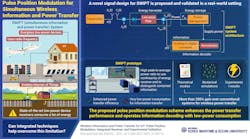Pulse-Position Modulation Scheme Holds Promise for Wireless Transfer of Data and Power at Once
Simultaneous wireless information and power transfer (SWIPT) is a promising technology to connect and energize low-power devices wirelessly over a long distance, suiting it for IoT implementations. But today’s state-of-the-art low-power SWIPT receivers still consume much more energy for communication than the amount they can harvest, which hinders further development and growth of the IoT ecosystem.
In a potential game changer, scientists at the Korea Maritime and Ocean University developed an innovative signal design for a simultaneous wireless information and power transfer system. The proposed pulse-position modulation (PPM) scheme enhances power-transfer efficiency and reduces data-decoding energy consumption—a double advantage—besides performing better than conventional systems. The technique may ultimately bolster IoT technology.
Prior work in the SWIPT arena highlights two common receiver architectures based on time-switching and power-splitting schemes. While these designs can be implemented using conventional energy and information modules, they don't tap the potential benefits of an integrated system. Therefore, researchers also have suggested an integrated receiver architecture (IntRx).
New Signal Design for SWIPT with IntRx
Recently, Dr. Junghoon Kim of the Korea Maritime and Ocean University and his colleague, Bruno Clerckx, proposed a novel signal design for SWIPT with IntRx architecture. “Our motivation was to design a suitable signal to be used in an integrated type of receiver for the SWIPT system. The signal can bring information and power together and be decoded and harvested by a single integrated-type receiver,” explains Dr. Kim.
How does their system work? To begin with, they modified a conventional pulse-position modulation scheme (M-PPM) to make it suitable for SWIPT IntRx. It encodes information on the pulse position and transmits high-amplitude pulses for short periods. Consequently, the high peak-to-average-power ratio of this new signal leads to higher harvesting power at the receiver compared to the conventional signals, which continuously deliver the same level of average power.
This improvement is based on a higher instantaneous power-conversion (RF to dc) efficiency owing to the high peak-to-average power ratio (PAPR) signal design that takes advantage of the nonlinearity of the energy harvester's rectifier. Simultaneously, the receiver can extract the information from the rectified signal by finding the position of the pulse in a specific duration. Therefore, the non-coherent modulation method allows for decoding without power-consuming RF components such as a low-noise amplifier (LNA) and mixer, making it suitable for low-power SWIPT IntRx systems.
The team also implemented a SWIPT testbed in an indoor environment and verified the benefit of their new signal design in a real-world setting. The experiments showed the IntRx system and PPM signal pair to have more than 200% gain over conventional methods regarding wireless power transfer. They also confirmed that a low-power data-decoding scheme works well in reality. Moreover, the findings were consistent with theoretical and numerical calculations.

